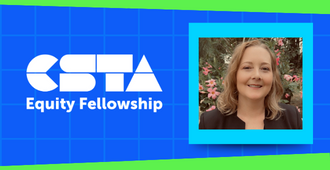
“I entered the teaching profession to make a tangible difference in students’ lives,” said CSTA Equity Fellow Elizabeth Naameh.
Full Story
“I entered the teaching profession to make a tangible difference in students’ lives,” said CSTA Equity Fellow Elizabeth Naameh. “As I see it, girls and students of color are underserved and underrepresented in mathematics, computer science, and STEM more broadly. While students experience math- and CS-aversion as an intensely personal problem, I view it as a structural one⦠but we can do something about it!”
Naameh is a math and computer science teacher for grades 9-12 at USC Hybrid High in Los Angeles, California. She founded the AP Computer Science program at her high school and lectures at UCLA through the AP Readiness program, which brings high-quality AP instruction to students and professional development for teachers. She’s a committed advocate for girls and students of color in STEM, working to expand notions of “who” does CS.
“I consider diversity, equity, and inclusion essential elements in my pedagogy,” shared Naameh. “As a math teacher, I am acutely aware that our current mathematics curriculum was never designed for many of my students and of the “stereotype threat” that hangs over them. I am aware of the dearth of color in those fields and professions that literally design our world – from computer science and engineering to architecture and policy-making. I am aware, too, of the overwhelming whiteness of fellow teachers and of the implicit messages these color lines send to our students.”
“So all of this comes to bear on my teaching,” Naameh continued. “Traditional textbooks must be supplemented with caring scaffolds. Rote exercises must be replaced with collaborative discovery. Archaic theorems must be grounded in culturally relevant applications. Increasingly, I see that it is my role to explicitly build these skills of argumentation, analysis, and reading and writing. It is imperative that students expand their vocabulary, not just for a content-related discussion, but for successfully navigating dominant society.”
Since Naameh has begun teaching computer science, she’s seen success in her recruitment. In her second year of teaching AP Computer Science, 50% of her students were girls – up from 11% the prior year. Naameh ties this increase to her classroom-to-classroom recruiting spree, where she engaged students in a presentation and discussion on inequities in the field.
This success allowed Naameh to found the computer science department to bring CS to new places and expose more students to the wonders of computing. In her CS Principles class, Naameh saw 34 students enroll, with several students auditing the class, as they didn’t have room in their schedules. She also works to keep her students engaged.
“I make sure students are engaged by keeping lectures and activities lively, interspersed with checks for understanding and opportunities to demonstrate mastery and co-construct knowledge,” said Naameh. “My pedagogical style is high-energy, inquiry-based, and discovery learning. I make sure to introduce new concepts by drawing analogies and parallels to students’ existing knowledge, thus validating their own experience and bringing their background into the classroom – I want the concepts to feel RELEVANT and NATURAL!”
Naameh works outside the classroom on the AP Readiness program. Monthly, she drives to UCLA and UC Riverside and delivers lectures and activities on topics relevant for learning and the AP exam to students bussed in to attend the free lectures.
“AP Readiness allows students to work with master instructors, who prepare them for the rigorous curriculum that they will face in AP courses,” said Naameh. “Concurrently, their AP teachers observe and learn from the master instructors, gathering a framework for how to successfully conduct an AP course. This unique program allows for students and teachers to learn together! This opportunity has been life-changing for me as I graduated from chaperone/observer to lead instructor in my own right. The partnership has challenged me to deeply consider best practices and model culturally responsive teaching.”
Through the CSTA Equity Fellowship, Naameh is looking to transform her teaching practice. “I want to learn how to empower my students beyond just the content of the class, but to feel confident and competent in undertaking new endeavors, in engaging in productive struggle. I want to steal best practices with a focus on outcomes and engagement.”
“I hope this fellowship will equip me with the tools, relationships, and mindsets to continue this learning and to make meaningful and scale-able changes in my own work and in the broader world of advocacy and education policy so that all students have access to a quality CS education.”
Naameh is currently working with a group of equity fellows on creating a series of workshops geared toward K-12 educators on culturally responsive computing. Many teachers currently do not have resources to help them integrate culturally responsive teaching across the grade bands. This series of workshops shows how a progression from the elementary, to the middle, to high school grades can build upon each other to support work done in earlier grades. The first workshop is on “Knowing Yourself: Affirming Students’ Identity, Cultures, and Heritage.” The second workshop is on “Knowing Your Community: Affirming Student Voices” and the third workshop is on “Knowing Your World: Situating CS in Social Issues.” All these workshops, moving from the local to the global, explore how we can harness CS to address socially relevant issues and include the lives and identities of our students.
You can learn more about Naameh, this year’s cohort, and the CSTA Equity Fellowship program here.



